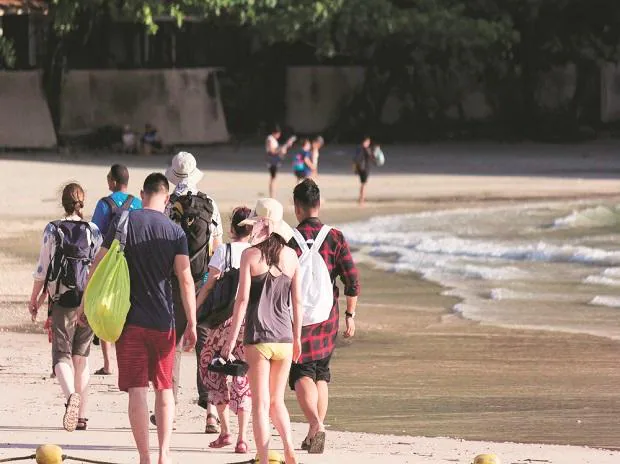The 2013 flash flood that swept away thousands in Uttarakhand is still fresh in the memory. Worn out posters of missing people can still be spotted on the walls in parts of the state, as families are looking for some closure. Recalling the tragic event, locals now say that the river had come down to cleanse Uttarakhand of its greed.
A few months later, the Uttarakhand high court had directed the state to halt any construction “within 200 metres from the bank of any river in the state”. But illegal constructions still dot the riverbeds. And it is not just Uttarakhand, other parts of the country have also witnessed a drastic jump in tourist footfall. From Kashmir to Kanyakumari, tourist spots are bursting at the seams. And this phenomenon is called over-tourism. And it is not limited to India only.
But, globally, countries are taking steps to protect their tourist spots. Starting January 2023, Venice will charge day-trippers between $3 and $10 to limit tourists.
Last year, Italy had banned cruise ships from entering Venice following years of warnings that waves generated by them were causing irreparable damage to the foundations of the flood-prone city. Before the pandemic, the UNESCO world heritage site attracted 30 million tourists a year.
Amsterdam and Barcelona have banned new hotel developments in their respective city centres to fight back over-tourism.
Half a world away, India’s neighbour Bhutan will reopen for international tourists on September 23 after two-and-a-half- year. The Himalayan kingdom also tripled its Sustainable Development Fee it charges visitors to $200, up from $65 charged for three decades. When it comes to sustainable tourism, Bhutan has always stayed ahead of the curve.
In India, the travel and tourism sector is now a $194.3 billion market, contributing 6.8% to GDP and employing 40 million people in 2019. But it comes at a cost. The impact of over-tourism can be social, economic, as well as environmental.
According to a 2017 study, major problems associated with tourist overcrowding include alienated local residents, degraded tourist experiences, overloaded infrastructure, damage to nature, and threats to culture and heritage.
Over-tourism leads to congestion of public spaces in city centres, rise in real estate prices, loss of residents’ purchasing power, commercialisation and environmental deterioration, including waste, noise, air quality and water quality issues.
Rising disposable incomes, young population and growing interest in adventure activities are driving tourism demand. But India has a poor track record in sustainable tourism. While it has improved its overall rank to 34th position in WEF’s Travel & Tourism Competitiveness Index in 2019, its rank under Environment Sustainability has been 139, 134 and 128 in 2015, 2017 and 2019 respectively.
CB Ramkumar, Board Member and South-Asia Director, Global Sustainable Tourism Council, says we should never get to a stage where tourist entry is restricted. Up to $10 daily fees for day-trippers in Venice may not be enough. Preservation of culture should take precedence over issues of access, he says. Some beaches in Goa are at high risk.
In India, domestic tourists contributed to 89% of overall tourism spending. India’s domestic tourists increased 60%, from 270 million in 2002 to 2.32 billion in 2019, consistently constituting 99% of overall tourists. But most tourists also leave a trail of destruction. Every year, the roads leading up to hill-stations across India witness thousands of vehicles getting stuck in horrible traffic jams.
From trekking in Himachal Pradesh, rafting in Uttarakhand to para-sailing in Goa, thrill- seeking people are also leading the rapid growth in demand for adventure tourism in some of the most sensitive ecological hotspots.
Over-tourism places pressure on fragile ecosystems causing degradation of the physical environment and disruption to wildlife. And not to mention the negative effects it produces on local communities. Popular hill destinations, particularly those in the Himalayan region, are testing their carrying capacities.
Santhosh Kanna S, Vice-President & National Sales Head – Leisure Travel, Thomas Cook (India) Ltd says as tourism demand increases, supply side responds automatically. More destinations open up, infrastructure develops. Some destinations may require demand control, he says.
The effects of over-tourism are severe. Many destinations are at risk of losing their appeal as desirable tourism destinations, which helps no one.
An example of authorities taking extreme measures against over-tourism is Thailand’s Maya Bay. The white sand beach made famous by the 2000 film ‘The Beach’ starring Leonardo DiCaprio reopened in January this year after being closed for three years. The break was required for coral reefs to recover from the damage by constant tourist activities.
But it will be closed again from August to September. In India, private and public infrastructure needs to catch up with the current demand and prepare for the coming decades as well. The stakeholders should act before the damage done becomes irreversible, by creating a sustainable balance between visitor numbers and the conservation of natural and cultural heritage.










